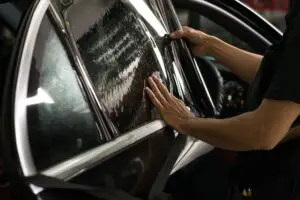Tinting windows of automobiles is a very common act.
You are allowed to tint the vehicle’s windows and windshield to escape the sun’s glaring warmth or to stave off the sun’s rays from interrupting your driving.
Fortunately, it is not considered criminal as long as you follow the laws and regulations that govern the procedure.
These rules have been in effect since the 90s, so you must follow them to prevent encountering the consequences of breaking them.
West Virginia window tint laws indicate that windshields of passenger or multipurpose vehicles must use non-reflective tints.
You can only tint the top five inches of the windshield. The laws imply different for all the other windows. Therefore it’s better to read this article to learn more.
To assure that you do not break the law, this article will walk you through the procedure and provide you with all of the important information on tinting your automobile in West Virginia, so then keep on reading.
If you need information about different levels of darkness on windows, I have included a frequently asked questions section at the bottom that will guide you best, so do not miss out.
Table of Contents
- 1 How Much Tint Darkness Is Legal In West Virginia?
- 2 Window Tint Reflection And Tint Colors
- 3 Medical Exemption Of Window Tint Laws In West Virginia
- 4 Get A Certified Sticker From The Company
- 5 Other Window Tint Law Rules And Regulations In West Virginia
- 6 Cost Of Car Window Tint In West Virginia
- 7 Frequently Asked Questions
- 8 Conclusion
How Much Tint Darkness Is Legal In West Virginia?

How much tint darkness is legal for your windows is usually determined by VLT, which stands for Visible Light Transmission.
The percentage will tell you how dark or light you can go. It is different for every state, so the study is required.
If you are unfamiliar with this, here’s an example to help you understand better, if the VLT percentage is low, the window will be darker.
So if the tint is 15%, the window will only permit 15% of light to pass through. Read down below the VLT for certain vehicles.
Tint Darkness Limit For SUVs And Vans
The state law of West Virginia only allows tint that is not reflective for windshields.
The darkness is also only allowed on the top five inches. The main purpose of this tint is to protect from the sun’s glare while you drive.
The darkness limit is different for the front side windows, mainly for visibility and privacy. It can be in any color except red, yellow, or amber.
So be aware that the tint is not allowed to be less than 35 percent. This means that 35 percent of light should be passing inside the vehicle.
Moving on to the back side windows and the rear window, the state law did not specify the darkness limit for them.
This indicates that you are allowed to use any darkness limit on them. However, it is best not to go too dark because it can affect vision.
Tint Darkness Limit For Sedans
You can tint all of the windows of your sedans, but be aware that their laws are distinct. It can pose problems if you are not aware of them, so learn more.
1. Front Windshield
For sedans, the windshields must not be reflective and only attained on the top five inches.
Just make sure not to use the colors red, yellow, and amber. It will assure you to keep the glare away, especially when driving at night.
2. Front Seat Side Windows
The front-seat side windows should permit 35 percent light inside the car, nothing less or more than that.
3. Rear Window
The rear windows also have a darkness limit, so you cannot choose any darkness, usually common in various states.
According to the law, the rear windows must pass through 35 percent of the light inside the vehicle.
4. Back Seat Side Windows
Lastly, the tint darkness limit for back-side windows is 35%. Make sure to not put a tint that is less than 35%.
Window Tint Reflection And Tint Colors
- Many individuals are unaware that laws stipulate how much of a reflection your car’s tint can have, so you should go over this section and observe the rules.
- The tint reflection law applies mainly to your car’s front and back windows.
- The front and rear side windows of sedans should reflect no more than 20% of the light.
- The same law applies to SUVs and vans’ front and backside windows.
- Except for red, yellow, and amber, any tint color can be used on your windows.
Medical Exemption Of Window Tint Laws In West Virginia

Medical exemptions to tinting laws are approved under West Virginia window tint standards.
So if you require a darker film for your car’s window than reach out to a medical consultant such as a doctor or optometrist about obtaining an exemption which will permit you to get a darker window tint for your car.
Simply keep documents demonstrating your eligibility for the medical exemption in the car all the time.
Get A Certified Sticker From The Company
The state of West Virginia expects approved window tint stickers to be affixed to the interior part of the window glass and the film.
It should be placed on all sides where it is also observable and clear to see.
Other Window Tint Law Rules And Regulations In West Virginia
Aside from the rules I discussed earlier, there are a few other rules and regulations to follow. I mentioned them earlier, but I’ll go over them again to make sure you understand.
- In West Virginia, the film manufacturers are required to verify the film they retail. Inquire with your dealer about the use of certified film.
- Dual side mirrors are required inside the vehicle if only the back seat side windows behind the driver’s seat are tinted.
- The stickers are compulsory on the glass and the film. They should be stuck on every window that has been tinted.
- If you require tinting darker than the usual tint, you will be granted a medical exemption.
- People who do not follow the rules in West Virginia will get penalties like misdemeanors, including a fine of $200 utmost.
Make sure you don’t break these regulations because they’re in a place to keep you safe and comfortable on the road. Rules also tend to change, so keep a regular check.
Cost Of Car Window Tint In West Virginia
It will cost between $135 and $150 to tint a two-door automobile. Cars with four doors cost between $160 and $170 on average.
Aside from that, two front windows are priced between $70 and $85. Finally, SUVs cost between $165 and $190 per month.
However, the cost may vary depending on the warranty, type of tint material used, location of installation, and the number of windows tinted.
Frequently Asked Questions
Q1. Is 15% Tint Legal In West Virginia?
15% tint is not legal in West Virginia. You cannot let less than 35 percent of light inside the vehicle. It will be too dark.
Q2. Are 5% Tints Legal In West Virginia?
5% tints are also not legal in West Virginia. This shade is the darkest, but the darkest you can go on your windows in West Virginia is 35 percent.
Q3. Is Limo Tint Legal In West Virginia?
No, you cannot use Limo tint on vehicles in West Virginia, whether it is passengers or multi-purpose cars.
Q4. Can I Get Pulled Over For Tint In West Virginia?
Yes, you can if the windows and the windshield that are tinted in your vehicle are not following the rules.
Q5. How Much Is A Tint Ticket In West Virginia?
In West Virginia, window tint citations can cost up to $200 per infringement.
Conclusion
West Virginia tint laws must be given attention to protect your face and your skin while driving.
It can get pretty hot in West Virginia; therefore, tinting your vehicle’s windows will certainly be a great idea.
You may tint your car’s windshield and other window glass when you are fully aware of the applicable legislation.
It is worth mentioning that tinting the windows will assist in minimizing the fraction of warmness and glare that enters the vehicle.
This is because direct sunlight will not travel past the window glass and the film.

I am Tahir Azam, and I have been writing amazing articles for TaxiHack for as long as I can remember. I know everything that is to know when it comes to automobiles and is always on top of industry news and developments. While I am not an expert by any means, I pride myself on knowing the ins and outs of many different problems and, of course, their solutions. The articles on our website are some of the best and well-researched content that you will find, and I spend countless hours making sure this remains to be true. This is why I ask you to take your time out and read some of my articles, especially if you find a topic that resonates with you or is something you are looking into. This way, you will find the perfect mix of information and tips on your desired topic. Learn more about Tahir.




